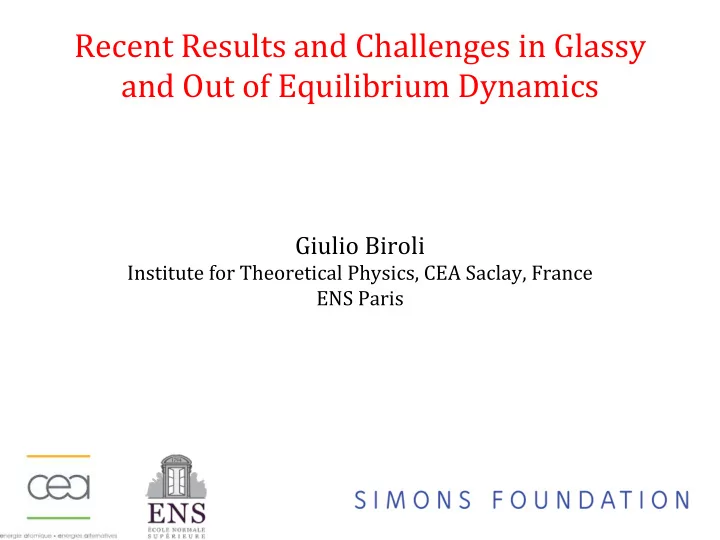

Recent Results and Challenges in Glassy and Out of Equilibrium Dynamics Giulio Biroli Institute for Theoretical Physics, CEA Saclay, France ENS Paris
Mean-Field Disordered Systems Spin-glasses, glasses, optimization problems, neural networks,... • Thermodynamics From Parisi’s solution of mean-field spin-glasses to rigorous proofs of replica symmetry breaking phase (’79-now) • Dynamics (Langevin, Montecarlo) From Cugliandolo-Kurchan solution of the out of equilibrium dynamics to a theory of aging in glassy dynamics (’93-now) Open problems and New Questions on Dynamics •Dynamics due to non-conservative forces and chaos •Barrier-crossing and dynamics on exponentially large time-scales
Lotka-Volterra equations for large interacting ecosystems 2 3 dN i X 5 + λ dt = N i 4 (1 − N i ) − α ij N j i = 1 , . . . , S N i ≥ 0 j, ( j 6 = i ) S → ∞ α ij non-symmetric Gaussian random matrix with i.i.d elements ij i c = σ 2 h α ij i = µ h α ij α ji i c = γ h α 2 ij i c − 1 ≤ γ ≤ 1 h α 2 S S •Dynamical phase diagram and dynamical phases? • High-dimensional disordered dynamical system •Out of equilibrium dynamics? • A representative model to address new •Transition to chaos? and central issues in ecology-biology (large ecosystems e.g. Human Microbiome) •Relationship with spin-glasses?
Dynamical Mean Field Theory Similar to DMFT for spin-glasses: Sompolinsky, Zippelius (1981); Ben Arous, Dembo, Guionnet (2000)
Dynamical Mean Field Theory h = 0 1 1 X X h N i ( t ) N i ( t 0 ) i = C ( t, t 0 ) h N i ( t ) i = m ( t ) Solution S S i i Similar to DMFT for spin-glasses: Sompolinsky, Zippelius (1981); Ben Arous, Dembo, Guionnet (2000)
Dynamical Phase Diagram γ = 1 aging like in a spin-glass γ < 1 “Complex” phase Chaos •Properties of the transition to chaos? EXACT SOLUTION •Stable chaos without immigration? G. B., G. Bunin and C. Cammarota arXiv:1710.03606 and works in progress (F. Roy, V. Ros) •Other equations, new phases? Related works and phase diagrams Sompolinsky, Crisanti, Sommers ’88 ; Diederich, Opper ’89; Fisher, Mehta ’14; Kessler, Shnerb ’15; Bunin ’16
Barriers and Dynamics on Exponentially Long Time-Scales Stochastic Dynamics of N X X S 2 i 1 = N E = − J i 1 , ··· ,i p S i 1 · · · S i p Mean-Field Glassy Models i 1 =1 (e.g. p-spin spherical model) h i 1 , ··· ,i p i i 1 = 1 , · · · , N Σ k ( e ) = 1 Very Rough Energy Landscape N ln N ( e ) Exponential number of critical points N ( e ) ∼ e N Σ k ( e ) Σ k ( e ) Complexity of critical points of index k Cavagna, Giardina, Parisi (1998) Auffinger, Ben Arous, Cerny (2013) barriers ~ N • T<Td out of equilibrium dynamics: aging for after (no barrier crossing) N → ∞ t → ∞ Dynamics on exponentially large Activated dynamics and in N time-scales? Barrier Crossing?
Complexity of Barriers • Using the Kac-Rice method developed in V.Ros, G. Ben Arous, G. Biroli, C. Cammarota, 2018 σ 0 is a given minimum V. Ros, G. Biroli, C. Cammarota to appear
Complexity of Barriers • Using the Kac-Rice method developed in V.Ros, G. Ben Arous, G. Biroli, C. Cammarota, 2018 Iso-complexity curves: Σ ( ✏ x , q | ✏ 0 ) = x •Lowest barrier to escape from a minimum is lower than the threshold •Exponential number of barriers Full geometrical structure of barriers? Generalized Freidlin-Wentzell theory? V. Ros, G. Biroli, C. Cammarota to appear
Dynamics • Full analysis in the Random Energy Model: on exponentially large time-scales the aging dynamics is the one of the Bouchaud trap model Simple arguments, simulations and rigorous proofs: Ben Arous, Bovier, Gayrard (2002), Junier, Kurchan (2004), Cerny, Wassmer (2017), Gayrard (2018), Baity-Jesi, Biroli, Cammarota (2018) For general mean-field glassy systems: a central open problem Promising route: large deviation theory combined with dynamical mean-field theory and inspired by the results on complexity of barriers
Recommend
More recommend